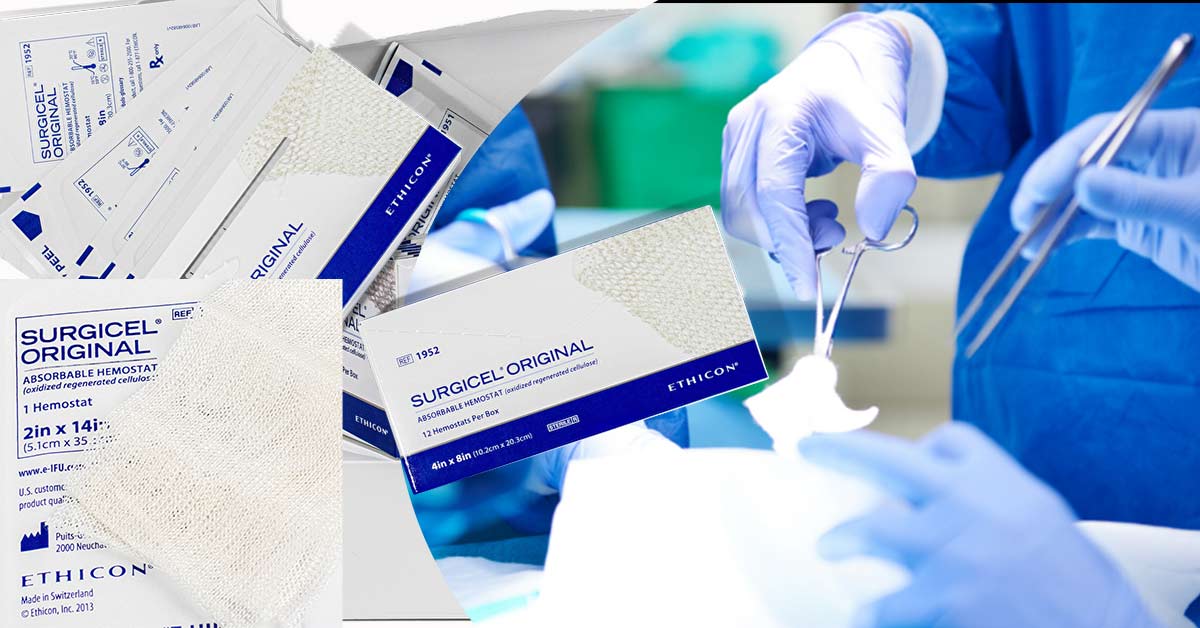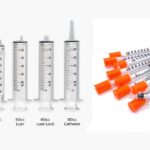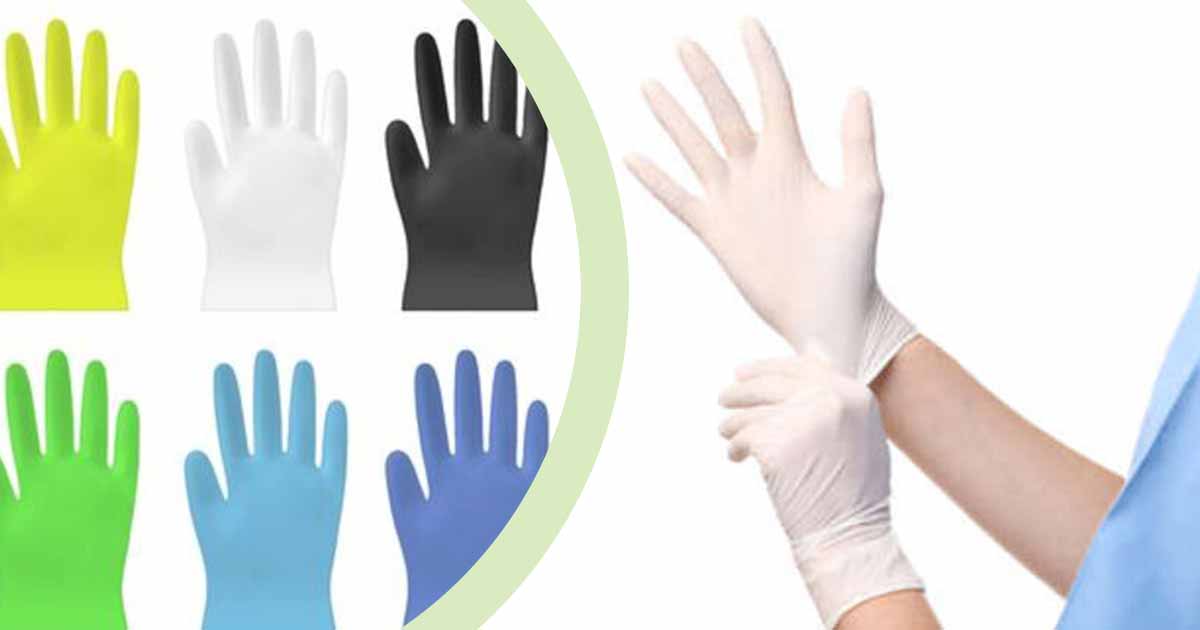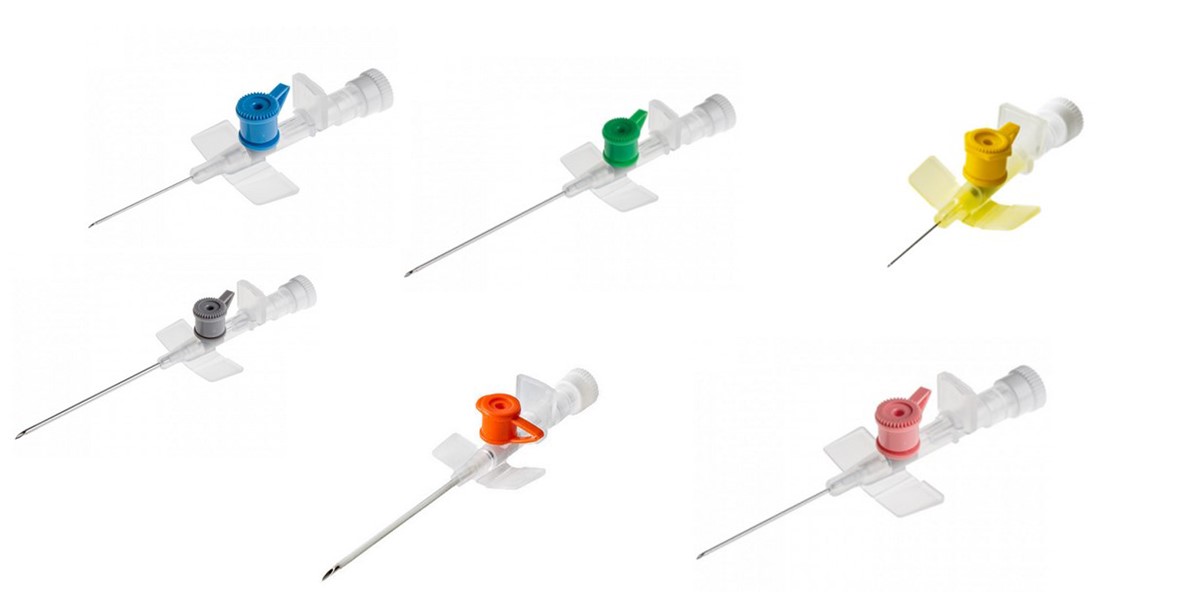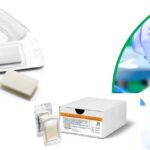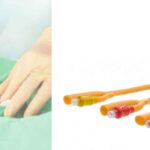Surgicel, an absorbable hemostat, is a sterile absorbable knitted fabric that is produced through a controlled oxidation of regenerated cellulose. The fabric material is strong, and does not fray when cut and used for suturing. It has a white color with a pale yellow cast and a faint, caramel-like aroma. Though, it can discolor slightly with age, but performance is not affected.
Since the surgicel is sterile, sterile technique should be employed in removing it. Minimal amount cut in different sizes are placed in the bleeding site or held firmly against the tissue to achieve hemostasis.
Surgicel was manufactured by Ethicon, a subsidiary of Johnson and Johnson, and introduced into the clinical practice in 1947.
Different Forms
Surgicel is supplied in different product types and sizes, such as:
- Surgicel® Powder (3.0g), with a shelf life of 18 months
- Surgicel® SNoW™ (1in x 2in, 2in x 4in, 4in x 4in), with a shelf life of 2 years
- Surgicel® Nu-Knit (1in x 2in, 2in x 4in, 4in x 4in), with a shelf life of 3 years
- Surgicel® NU-KNIT™ (3in x 4in, 6in x 9in), with a shelf life of 5 years
- Surgicel® Original (0.5in x 2in, 4in x 8in, 2in x 3in, 2in x 14in), with a shelf life of 5 years
How does Surgicel Work?
Surgicel increase the rate of clotting through a poorly understood mechanism. However, it is not known to affect the normal physiologic clotting mechanism. Rather, the effect is physical.
The absorbable hemostat becomes saturated with blood, it swells into a brownish or black gelatinous mass, helping to form a clot, and acts as a hemostatic adjunct to control local hemorrhage.
The surgicel is absorbed from the site where it is implanted, with no tissue reactions.
Clinical Indications of Surgicel
Local Hemostatic Action
The surgicel absorbable hemostat (oxidized regenerated cellulose) serves as an adjunct during surgical procedures to help control capillary, venous, and small arterial hemorrhage, when other methods of control such as ligation are not effective. It is absorbed from the sites where it is used.
Such procedures where surgicel can be used include abdominal, thoracic, neurosurgical, orthopedic, and otorhinolaryngologic procedures. Others include hemorrhoidectomy, gallbladder surgery, partial hepatectomy, amputation, resection or injuries to the thyroid, breast, bowel, pancreas, kidney and prostate.
Surgicel is also a hemostatic adjunct in such gynecologic procedure like hysterectomy, conization of the cervix (cone biopsy or cold knife cone biopsy), oophorectomy, and repair of cystorectocele.
It also controls bleeding in tonsillectomy, adenoidectomy, tympanoplasty, Stapes surgery, epistaxis, nasal polyp removal, surgery for sinusitis, repair of deviated septum, and removal of tumor.
The absorbable hemostat is also used in punch biopsy, excision biopsy, finger and toenail removal, curettage, traumatic wounds, and after dermabrasion.
In dental procedures, surgicel is used to control bleeding in exodontia and oral surgery, and to achieve hemostasis after single or multiple tooth extractions impactions, biopsies, alveoloplasty, gingival hemorrhage, and other procedures in the oral cavity.
Surgicel is reported to help in controlling bleeding in cardiovascular surgery. It has also been used as a surface dressing on donor sites and superficial open wound to control bleeding, as it does not cause delay in healing, neither does it interfere with epithelization.
Bactericidal Effect:
In addition to its local hemostatic effect, surgicel has antibacterial effect (bactericidal effect) in vitro against various gram positive and gram negative organisms (both aerobes and anaerobes forms). However, it has no effect against experimental microbes. Some of the organisms it has bactericidal effect against include:
| Gram-negative Micro-organisms | Gram-positive Micro-organisms |
| Escherichia coli | methicillin-resistant Staphylococcus aureus (MRSA) |
| Shigella dysenteriae | penicillin-resistant Streptococcus pneumoniae (PRSP) |
| Proteus mirabilis | vancomycin-resistant Enterococcus (VRE) |
| Proteus vulgaris | methicillin-resistant Staphylococcus epidermidis (MRSE |
| Serratia marcescens | Lactobacillus sp. |
| Salmonella enteritidis | Staphylococcus epidermidis |
| Shigella dysenteriae | Bacillus subtilis |
| Pseudomonas aeruginosa | Corynebacterium xerosis |
| Pseudomonas stutzeri | Staphylococcus aureus |
| Klebsiella aerogenes | Micrococcus luteus |
| Branhamella catarrhalis | Clostridium tetani |
| Bacteroides fragilis | Clostridium perfringens |
| Streptococcus salivarius | |
| Streptococcus pyogenes Group A | |
| Streptococcus pyogenes Group B | |
| Mycobacterium phlei |
Precautions/Warnings
- The absorbable hemostat is stable and should be stored at room temperature (15° – 30°C).
- If the surgicel is opened and unused, it should be discarded since it cannot be sterilized.
- It should not be autoclaved, as it is supplied sterile, and autoclaving can cause physical breakdown of the product.
- The absorbable hemostat is not a substitute for careful surgery and the proper use of sutures and ligatures.
- Use the portion of the absorbable hemostat that is just enough to initiate hemostasis, and hold in place till bleeding stops.
- Though surgicel can be left in situ when required, it is recommended to remove it after achieving hemostasis especially when used around, or in proximity to foramina in bone, areas of bony confine, the spinal cord, and/or the optic nerve and chiasm, and in proximity to tubular structures that can constrict by swelling. The surgicel can swell, causing pressure and leading to paralysis and/or nerve damage.
- In otorhinolaryngologic surgery (like controlling hemorrhage after tonsillectomy and controlling epistaxis), you should make sure the patient does not aspirate any of the material.
- When used temporarily to line the cavity of large open wounds, the placing should be done to avoid overlapping the skin edges.
- When the bleeding has stopped, remove from open wound by forceps or by irrigation with sterile water or saline solution.
- In urological procedures, small amounts should be used to avoid plugging of the urethra, ureter, or a catheter by portions of the product.
- Apply the material lightly as a wrapping during vascular surgeries, as stenotic effect has been reported.
- Do not moisten with water or saline, as the hemostatic effect is better when applied dry
- The absorbable hemostat should not used to close a contaminated wound as it may cause complications.
- Surgicel should not be used for implantation in bone defects, such as fractures, as it may interfere with callus formation, possibly causing cyst formation.
- Use it loosely against the bleeding surface. Avoid wadding or packing, especially within rigid cavities, as swelling interferes with normal function or cause necrosis.
- Excess portion should be removed before closing the wound to improve absorption and reduce foreign body reaction like encapsulation of the product.
- Do not impregnate the surgicel with anti-infective agents or buffering or hemostatic substances. Thrombin does not enhance the activity, rather it renders it ineffective due to the low pH of the product.
Side Effects
When used as packing in epistaxis, the hemostatic agent may cause burning and stinging sensation due to its low pH. Burning has also been reported after nasal polyp removal and after hemorrhoidectomy.
Reactions such as stinging has been reported when used on surface wounds (varicose ulcerations,
dermabrasions, and donor sites). Burning, stinging and headache has also been reported in sneezing in epistaxis and other rhinological procedures.
Foreign body reaction and fluid encapsulation has also been reported.
References
- https://roiscs.com/wp-content/uploads/2022/06/JJ-Surgicel-Hemostat-1946-IFU.pdf
- https://www.jnjmedtech.com/system/files/pdf/SURGICEL-Family-Comparison-Table_0.pdf
- https://www.uhcw.nhs.uk/download/clientfiles/files/Patient%20Information%20Leaflets/Women%20and%20Children_s/Gynaecology/Colposcopy%20-%20Surgicel%20gauze%20.pdf

